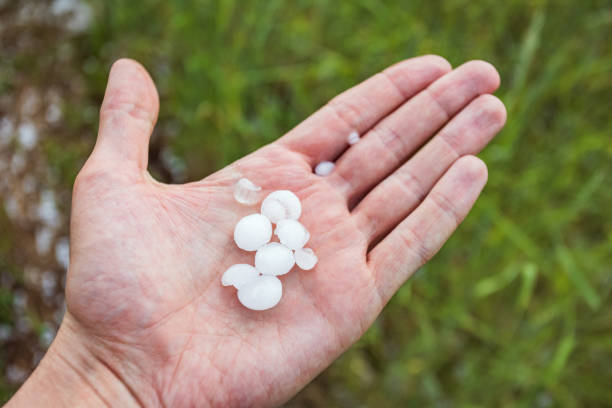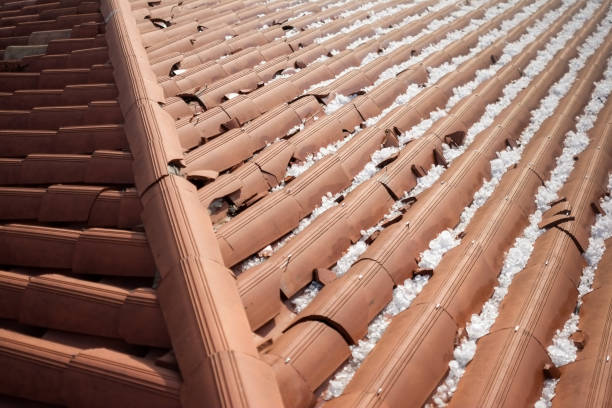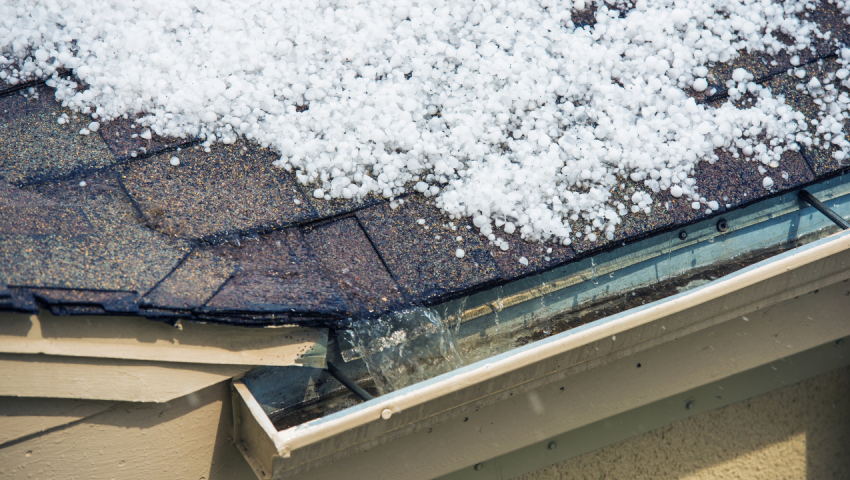Protecting your home with homeowners insurance should be a top priority when it comes to potential damage to your roof from hailstones. Understanding the impact of hail on different roofing materials like metal roofing and wood shingles is crucial for safeguarding your home.
Hailstorms can cause significant damage to roofs, including shingle damage and property damage. If left unaddressed, this damage can result in costly repairs. It’s important to address any shingle damage promptly, whether you have metal roofing or wood shingles.
So, how do you identify hail damage? What does it actually look like on a roof?
Below, Peak to Peak Roofing will explore common signs of hail damage to roof shingles, discuss the importance of prompt inspections by an adjuster after a storm to assess property damage, provide practical tips for addressing any issues that may arise in the process, and most importantly, answer the question: What does hail look like on a roof?
Detecting Hail Damage to Your Roof: What to Look for After a Storm

Inspecting your property’s roof after a hailstorm is a crucial process, as damage to the property may not always be immediately visible. Here are some key things to look out for when assessing the impact of storm damage, specifically hail, on your roof.
Missing or Damaged Shingles
One of the most obvious signs of hail damage is missing or damaged shingles. This is a common issue that occurs during the roofing process. Take a close look at your roof and check for any shingles that have been dislodged or completely torn off due to storm damage or a hail storm.
Pay particular attention to areas around valleys and edges, as these are more susceptible to hail impact and can cause roof damage. If you notice any missing shingles caused by hail stones, it’s essential to address the issue promptly to prevent further damage.
Circular Cracks or Splits in Wooden Shakes and Shingles
Wooden shakes and shingles can be vulnerable to hail damage. Inspect your roof carefully for circular cracks or splits caused by the impact of hailstones, as these can indicate roof damage. These cracks may not always be immediately noticeable, so it’s important to conduct a roof hail damage inspection and examine each shake or shingle individually for any signs of roof damage or hail damage.
If you spot any signs of damage, consider contacting a professional roofing contractor who can assess the severity and guide necessary repairs.
Soft Spots or Depressions
While it may not be evident at first glance, soft spots or depressions on your roof could indicate underlying hail damage. Hailstones can cause roof damage by creating dents in softer materials like asphalt shingles, compromising their structural integrity. Run your hand over the surface of your roof, paying attention to any areas that feel softer than others. If you detect roof damage or roof hail damage spots, it’s advisable to have a professional conduct a thorough inspection.
Indentations with No Visible Cracking
One of the most common signs of hail damage on a roof is the presence of indentations without visible cracking. When hailstones strike your roof, they can leave small dents behind. These indentations may not cause immediate cracks but can weaken the integrity of your shingles over time. To identify this type of damage, carefully inspect your roof for any irregularities in its surface texture.
Dents in Gutters and Downspouts
While examining your roof for signs of hail damage, don’t forget to check your gutters and downspouts as well. Falling hailstones can dent these metal components, providing further evidence of a recent storm with substantial-sized hailstones. Inspect these areas closely and look for any noticeable dents or deformations along their length.
Displaced Roofing Material Near Vents and Chimneys
In addition to examining the surface of your roof, it’s crucial to inspect areas near vents and chimneys for displaced roofing material. During a severe hailstorm, strong winds combined with large hailstones can dislodge shingles or tiles, causing them to shift or even fall off completely. Check for any loose or missing roofing material around these vulnerable areas.
When conducting a post-hailstorm inspection, keep in mind certain factors that could influence the extent of potential damage:
- Wind Direction: Consider the direction from which the wind was blowing during the storm to assess potential roof damage, such as roof hail damage. It is important to conduct a thorough hail-damaged roof inspection. Hailstones tend to hit roofs more forcefully when propelled by strong winds.
- Wind speeds: The speed of the wind can significantly impact the intensity of hail damage. Higher wind speeds often result in more severe roof damage.
By keeping an eye out for these signs of hail damage, you can promptly address any issues and prevent further deterioration of your roof. If you notice indentations with no visible cracking, circular marks resembling bruises, dents in gutters and downspouts, or displaced roofing material near vents and chimneys, it’s advisable to contact a professional roofer to assess the extent of the damage and recommend suitable repairs.
Hailstones can vary in size, with some reaching up to an inch in diameter or even larger. The severity of the damage may depend on the size and intensity of the hailstorm. Therefore, if you suspect hail damage but are unsure about its extent, it’s always best to consult a qualified roofing expert who can thoroughly inspect and guide you through the necessary steps for repair or replacement.
Assessing Hail Damage: Dents in Siding, Gutters, or Downspouts
Dented siding, gutters, and downspouts are common signs of hail impact. When a hailstorm hits a roof, it can cause significant damage to the exterior components of a house. One of the most noticeable effects is dents on the siding, gutters, or downspouts.
Vinyl siding is particularly vulnerable to hail damage. After severe hailstorms in Golden, CO, homeowners may find holes in their vinyl siding. The impact of large hailstones can create cracks or chips in wooden siding as well. These damages not only compromise the aesthetics of your home but also leave it susceptible to water infiltration.
Examine the Conditions of Gutters and Downspouts
When inspecting your property for hail damage, start by examining the condition of your gutters and downspouts. Damaged gutters can lead to water-related issues if left unaddressed. Look for dents along the gutter system that hailstones caused by their forceful impact. Check if there are any cracks or breaks that could hinder proper drainage.
Downspouts should also be thoroughly inspected for signs of damage. Hail impacts can dent these vertical pipes that carry rainwater from the gutters down to the ground. Even small dents can disrupt the flow of water and potentially cause blockages over time.
Examine the Shingles and Flashing
Check the shingles and flashing for any obvious damage, such as dents or indentations, to determine whether hail has affected your roof. While these damages may not always be obvious from ground level, they can have long-term consequences if left unattended.
If you suspect hail damage on your roof but cannot see it clearly from below, consider hiring a professional roofing contractor who specializes in storm damage assessments. They have experience identifying hidden damages that might not be immediately apparent to an untrained eye.
Understanding the Impact of Hail on Different Roofing Materials

Asphalt Shingles: Granule Loss and Bruising
Hailstorms can have a significant impact on various roofing materials, and asphalt shingles are no exception. When hail hits an asphalt shingle roof, it can cause granule loss or bruising. Granules are the small particles that cover the surface of asphalt shingles, protecting them from UV rays and providing fire resistance. Hailstones hitting the shingles can dislodge these granules, exposing the underlying fiberglass mat.
The extent of damage to asphalt shingles depends on factors such as the size and density of hailstones. Large hailstones with significant velocity can cause more severe damage, resulting in visible bruising or even punctures through the shingle layers. In some cases, weakened spots may develop after a hailstorm, making the affected areas susceptible to leaks.
Tile Roofs: Cracks and Breakage
Tile roofs are known for their durability, but they, too, can suffer from hail damage. When large hailstones strike tile roofs with force, they can crack or break individual tiles. This damage is particularly common in clay or ceramic tiles due to their brittle nature.
The impact of hail on tile roofs may not always be immediately noticeable since cracks might not be visible from ground level. However, over time, water infiltration through these cracks can lead to leaks and compromise the integrity of your roof’s structure.
Metal Roofing: Dents and Dimples
Metal roofing is generally more resistant to hail compared to other materials due to its durability. However, even metal roofs can display signs of damage after a severe hailstorm. Hailstones hitting metal surfaces may result in dents or dimples forming on the roof panels.
These dents may affect both aesthetic appeal and functionality. While smaller dents might not pose a significant risk, larger ones could potentially compromise your roof’s ability to shed water, leading to leaks. Inspecting your metal roof for any signs of hail damage is crucial, especially after a severe storm.
Wooden Shakes and Shingles: Splitting and Circular Cracks
Wooden shakes and shingles can also be vulnerable to hail damage. When hailstones strike wooden roofs, they can cause splitting or create circular cracks in the wood. These cracks may not always be immediately visible, but they can lead to future problems if left unaddressed.
Hail damage on wooden roofs can weaken the overall structure, making it more susceptible to moisture infiltration and rot. Regular inspections after a hailstorm are essential to identify any potential issues early on and prevent further deterioration.
Understanding the impact of hail on different roofing materials is crucial for homeowners in areas prone to severe weather conditions like Golden, Colorado. Whether you have asphalt shingles, tile roofs, metal roofing, or wooden shakes and shingles, being aware of the potential impacts allows you to take the necessary measures for timely repairs and maintenance.
Can Hail Damage on a Roof be Repaired?

Now, it’s time to address a pressing question: Can hail damage on a roof be repaired? The good news is that, in most cases, hail damage can be repaired. In this expert guide, we’ll delve into the process of repairing hail damage on a roof and what homeowners need to know.
Repairs for Minor Hail Damage
When dealing with minor hail damage, where only a few shingles have been affected, the repair process is relatively straightforward. Here’s a more detailed look at the steps involved:
- Shingle Replacement: Damaged shingles are carefully identified and marked for removal. Roofing professionals will systematically lift the damaged shingles and remove the nails holding them in place. This meticulous process ensures that adjacent, undamaged shingles remain intact.
- Underlying Inspection: Before installing new shingles, roofing experts inspect the underlying decking and underlayment for any signs of damage. This step is crucial because it aids in identifying potential structural problems that the hail impact might have caused.
- Selecting Replacement Shingles: The replacement shingles are chosen to match your existing roof’s color and style. This ensures a seamless appearance once the repairs are complete.
- Installation: New shingles are carefully placed and secured to the roof using appropriate nails or adhesives. Roofers pay close attention to alignment and proper fastening to prevent any future issues.
- Sealing and Securing: Loose or lifted shingles in the surrounding area are also resealed and securely fastened to prevent them from becoming susceptible to wind or further hail damage.
- Protective Coatings: In some cases, especially if your roofing material allows for it, a protective coating may be applied. These coatings can enhance the shingles’ durability and protect them from future hail and environmental damage.
- Quality Control: A thorough inspection of the repaired area is conducted to ensure that all damaged components have been replaced and that the repaired section matches the rest of the roof seamlessly.
Repairs for Major Hail Damage
When major hail damage occurs, the repair process becomes more comprehensive, often involving extensive repairs or even a full roof replacement. Here’s a more in-depth overview:
- Roof Replacement: In cases of severe hail damage, a full roof replacement is often the most cost-effective and safe solution.
- Underlayment Inspection: The damage assessment extends beyond the visible surface. Roofers will carefully examine the underlayment and decking for hidden damage that might lead to leaks or structural issues in the future.
- Interior Damage Assessment: If hail damage has resulted in water penetration, interior areas of your home, such as ceilings and insulation, may have been affected. These areas will also require inspection and repair to prevent further damage and ensure the integrity of your home’s interior.
- Roof Deck Repairs: In some cases, the hail impact may have damaged the roof deck itself. Roofers will replace or repair damaged sections of the decking to provide a solid foundation for the new roofing materials.
- Roof Replacement Process: The process of replacing the entire roof involves removing all existing roofing materials down to the deck. New underlayment, shingles, and roofing components are then installed following industry best practices.
- Quality Assurance: A thorough inspection is conducted at various stages of the roof replacement process to ensure that every aspect of the new roof meets high-quality standards.
- Cleanup: Once the roof replacement is complete, all debris and old roofing materials are removed from the property, leaving your home clean and safe.
Navigating Insurance Claims for Hail Damage: Important Considerations

Taking the right steps and understanding the insurance claim process can make a significant difference in getting the coverage you deserve. Here are some important considerations to keep in mind when navigating insurance claims for hail damage:
Document the Hail Damage with Photographs Before Making Any Repairs
Before you begin any repairs or cleanup, it is crucial to document the extent of the hail damage on your roof. Take detailed photographs from multiple angles to capture all visible damages caused by hailstones. These photos will serve as valuable evidence during the insurance claim process, ensuring you have proof of the condition before any repairs are made.
Contact Your Insurance Company Promptly to Report the Damage
As soon as you notice hail damage on your roof, contact your insurance company promptly to report the incident. Most homeowners’ insurance policies have a specific timeframe within which you must report damages. Failing to do so could result in a denial of your claim. Provide them with accurate information about the date and time of occurrence, location, and details regarding the extent of the damages.
Understand Your Policy Coverage and Deductible for Hail-Related Claims
Reviewing your homeowners’ insurance policy is essential to understanding what is covered. Familiarize yourself with terms such as “actual cash value” or “replacement cost value” and determine which applies to your policy. Take note of your deductible amount for hail-related claims, as this is typically an out-of-pocket expense you’ll need to cover before receiving reimbursement from your insurer.
Keep Records of All Communication and Expenses Related to the Claim Process
Throughout the entire claim process, maintain meticulous records of all communication with your insurance company, including dates, times, names of representatives spoken with, and summaries of discussions or agreements reached. This documentation will be invaluable in the event of any disputes or discrepancies that may arise. Furthermore, keep track of all expenses related to the claim process, such as temporary repairs, hotel stays (if necessary), and other costs incurred due to the hail damage.
Navigating insurance claims for hail damage can sometimes be a complex and lengthy process. Understanding your policy coverage, documenting damages, and maintaining detailed records will help ensure a smoother experience.
Considering these important considerations, you can increase your chances of receiving fair compensation from your insurance company.
Remember that every insurance company has its own claim process and may assign an insurance adjuster to assess the damages. Cooperate with the adjuster by providing them access to inspect your roof thoroughly. If you encounter any issues during the claim process or feel that your insurer is not handling your claim fairly, consider seeking advice from a professional public adjuster specializing in hail damage claims.
Taking Action Against Hail Damage on Your Roof
Taking prompt action is crucial to prevent further issues and ensure the longevity of your roofing system. Whether you reside in Golden, Colorado, or any other location prone to hailstorms, addressing the damage promptly can save you from costly repairs. Here are some essential steps to take when dealing with hail damage:
Consult a Professional Roofer to Assess the Extent of the Damage
After a severe hailstorm, it is advisable to consult a professional roofer in Golden or your local area who specializes in roof repairs and replacements. They have the knowledge and experience necessary to accurately determine the extent of hailstone damage. A thorough inspection will help identify any hidden problems that may not be immediately visible, such as cracks or leaks, that could lead to further complications if left unaddressed.
Repair or Replace Damaged Shingles, Tiles, or Other Roofing Materials Promptly
Once the assessment is complete, it’s essential to repair or replace any damaged shingles, tiles, or other roofing materials promptly. Damaged components compromise the integrity of your roof and can result in leaks and water infiltration during future storms. A professional roofer will recommend suitable replacement options based on your specific needs and budget.
In some cases where extensive damage has occurred across the entire roof surface, a full roof replacement might be necessary. While this may seem like a significant investment initially, it ensures long-term protection for your home and eliminates potential future problems stemming from compromised areas.
Address Any Underlying Structural Issues Caused by Severe Hail Damage
Hailstorms can cause more than just surface-level damage; they can also impact the structure beneath your roof. If there are signs of structural issues resulting from severe hail damage—such as matting underneath shingles or weakened supports—it’s crucial to address them promptly. Ignoring these problems can lead to further deterioration and compromise the overall stability of your roof.
Regularly Maintain Your Roof to Prevent Future Problems and Prolong its Lifespan
To prevent future hail damage, it’s essential to regularly maintain your roof. This includes inspecting for any loose or damaged shingles, checking seals around vents and chimneys, clearing debris from gutters and downspouts, and ensuring proper attic ventilation. By staying proactive with maintenance, you can identify potential issues early on and take necessary actions before they escalate into more significant problems.
In addition to regular maintenance, consider consulting a professional roofer in Golden or your area after each severe storm. They can offer a professional evaluation of any fresh hail or other environmental damage, enabling you to take immediate action.
By following these steps and working closely with a reliable roofing contractor or professional roofer, you can effectively combat hail damage on your roof. Remember that timely action is key.
What Does Hail Look Like on a Roof?
Hail can take various forms, from visible dents and cracks to displaced or missing shingles. Regular inspections and timely repairs are essential to maintaining the integrity of your roof and ensuring it protects your home from the elements.
By staying vigilant and addressing hail damage promptly, you can prolong the life of your roof and enjoy peace of mind in the face of future storms.
Now that you know what to look for, it’s time to take action! Don’t let those pesky hailstones wreak havoc on your home. Contact Peak to Peak Roofing & Exteriors today to assess any potential damage and discuss repair options. Remember, promptly addressing hail damage can prevent more significant issues.

